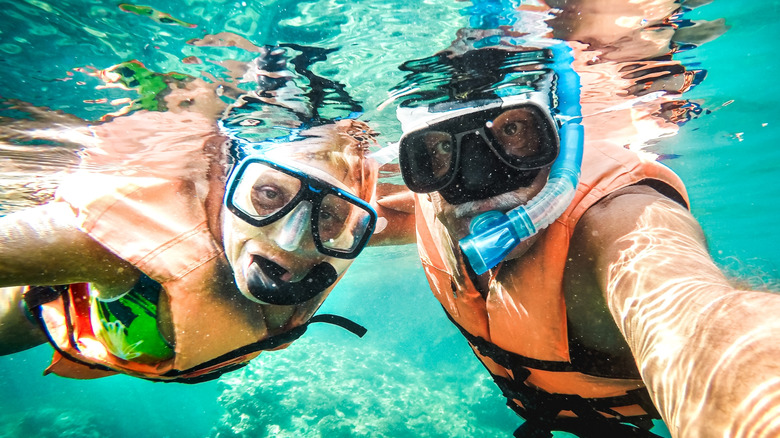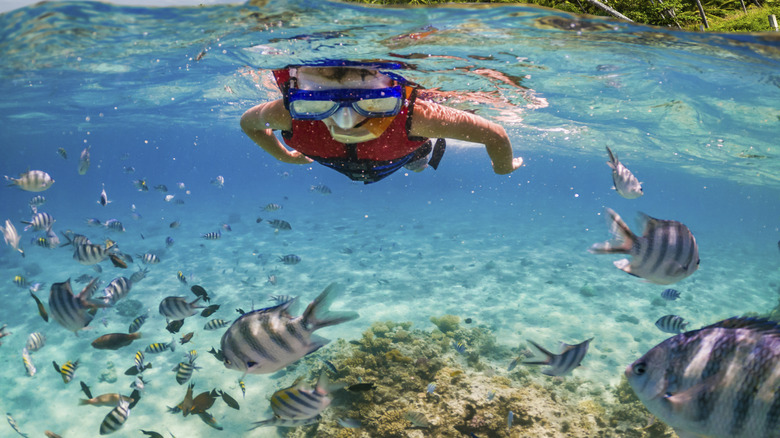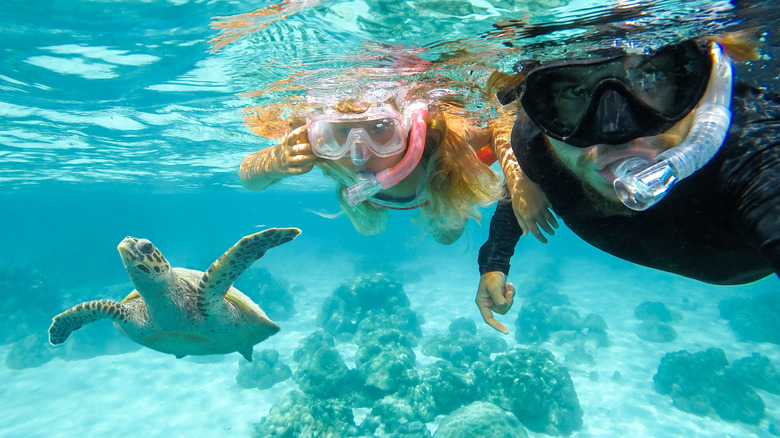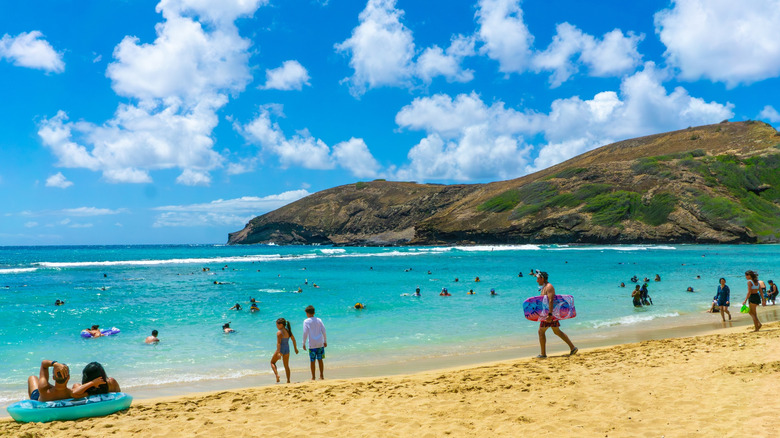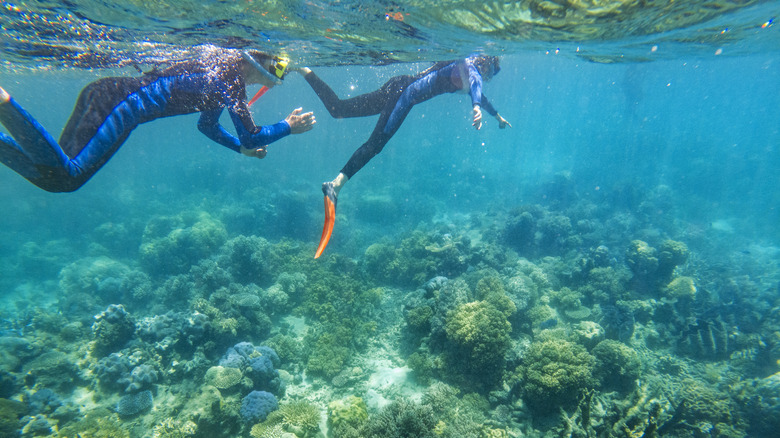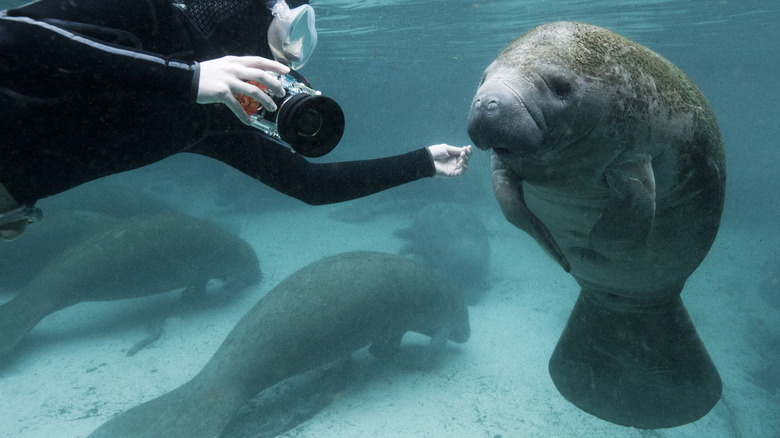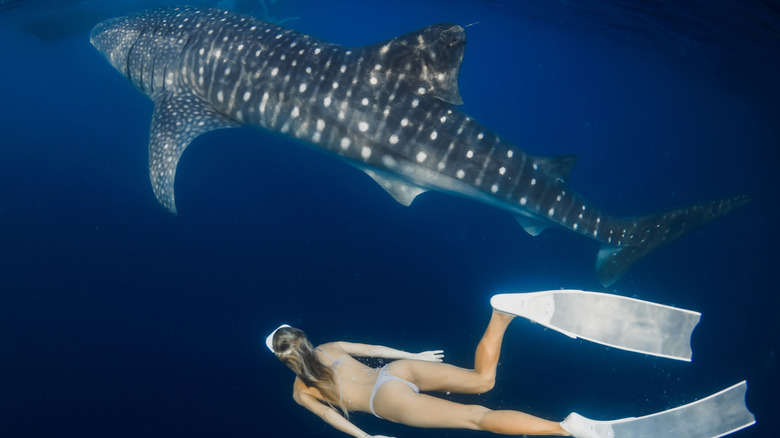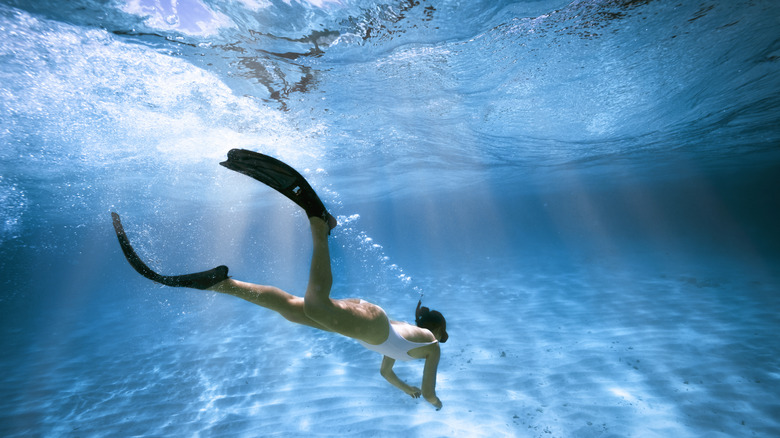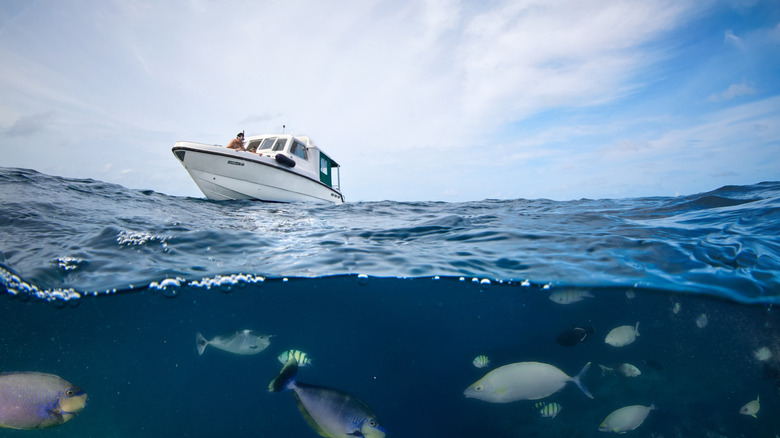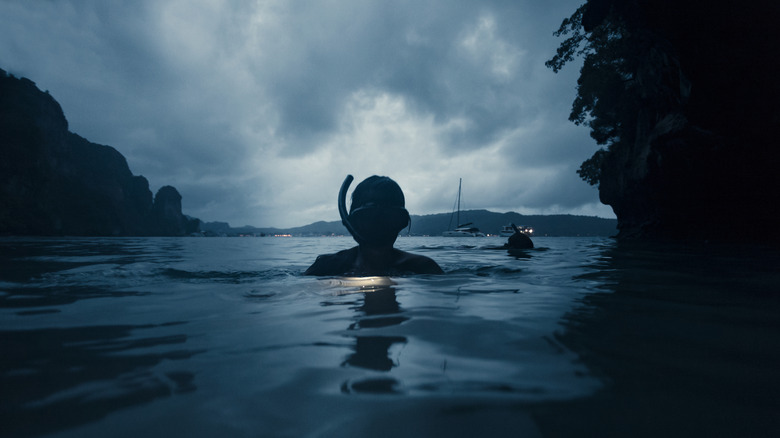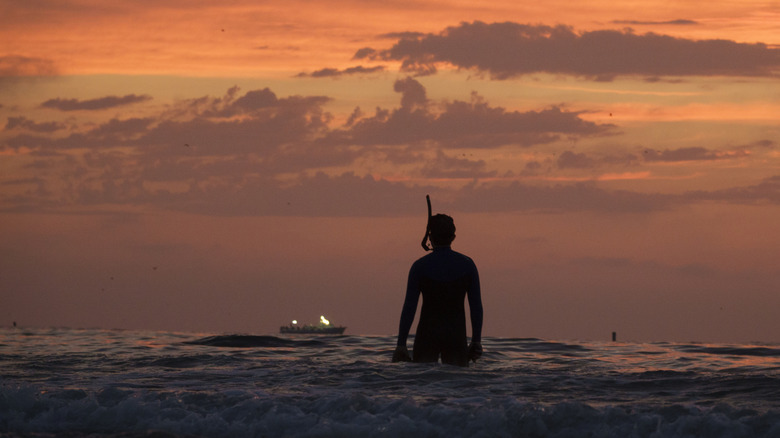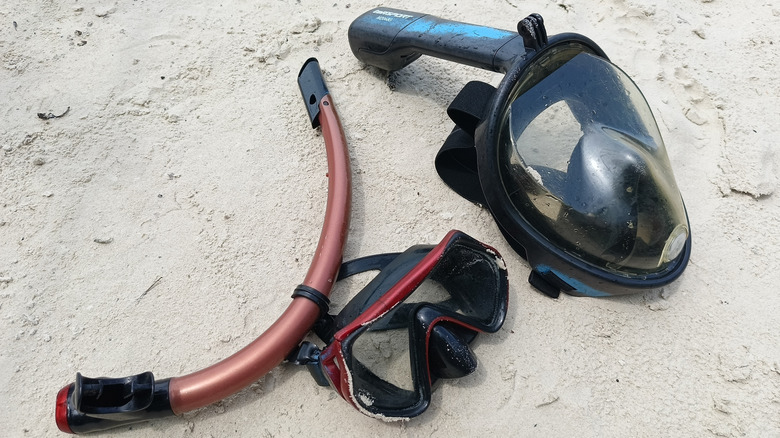How To Find The Best Snorkeling Locations For Beginners To Experts, According To Experience
Lazing on the beach with the sun warming your skin, a piña colada cooling your hand, and a good book holding your attention is all very well. But for some, this kind of beach life can get pretty boring pretty quickly. Maybe you want to try something a bit more exciting for your seaside activities. Maybe you've been casting curious gazes out at snorkelers and wondering what they were discovering. Perhaps you've seen vibrant coral and colorful fish on TV or on the pages of National Geographic and are eager to experience it firsthand yourself.
What's stopping you from discovering that underwater world down there? Is it that you aren't a confident swimmer or that you feel intimidated by the open water? Maybe you just don't know where to find beginner-friendly snorkeling locations, or maybe you're looking for safety tips before taking to the water. On the other hand, you might have already donned a mask and fins and are looking to move on from beginner-friendly sites to more challenging snorkeling locations.
You may even want to find new places where you can develop skills like drift snorkeling or freediving. Choosing the right spot ultimately depends on your skill, goals, and safety, and it's central to your overall enjoyment of the water. From safe snorkeling beaches for beginners and families to more challenging experiences out at sea, there are plenty of locations for all skill levels — you just have to know how to find them.
Spotting the best beginner-friendly snorkeling locations
When you're fully aware of the mistakes to avoid when snorkeling for the first time, you're ready to explore the underwater world. It's important that you choose a location suited to your ability, especially if you're not a strong swimmer. Calm, shallow waters are best. Look for protected bays, lagoons, and shallow reefs where you can feel safe and focus on building your skills.
Jetties can also be a good choice. They offer easy entry and minimal swimming distance, and because they provide shade, shelter, and hard surfaces for growth, they're often teeming with marine life. You'll need that abundance of sea creatures if you want to maintain excitement, and it's also a key factor when you want to inspire learning in young snorkelers.
However, you may not want to be jumping off jetties. If so, you should consider more suitable beginner-friendly alternatives. Locations with shore entries free of rocks are the easiest way for novices to adjust comfortably to both depth and the fickle gear needed for successful snorkeling. You'll also want to look for gentle conditions — places where the wind is light and the current is mild. And definitely check the weather forecast — although that's a given for any skill level.
It's much safer to avoid isolated spots where there is a lack of other snorkelers, too. At the same time, avoid overcrowded areas. The last thing you need is flailing limbs and splashing fins when you're just trying to focus on mastering the basics of your new hobby. However, as a beginner, the best piece of advice you can have is to buddy up. For safety, beginners should never snorkel alone, especially when attempting a quiet location with no lifeguard on duty.
What to look for in family-friendly snorkeling spots
When it comes to snorkeling with young children, there are other factors to consider on top of beginner-friendly conditions. For example, it's always a good idea to seek locations with lifeguards on duty and emergency stations with trained staff. You may even want to opt for a supervised group tour with expert guides. They'll have all the flotation devices you need, teach basic snorkeling skills and safety signals, and sometimes even provide a lifeguard in the water. It's great if you have very young snorkelers or older kids who are less confident swimmers. They'll also educate on the local marine life to make the whole experience more intriguing for children.
Safety precautions aside, you'll want to consider things like easy bathroom access, shade, and rest areas. Family-friendly snorkeling sites usually have restrooms, picnic tables under trees, and places to rest, such as cafés or snack bars. If you're not taking a guided tour, you may want to check online that the place where you'll be renting snorkeling gear actually has child-sized masks, snorkels, and life vests. Pool noodles or inflatable floats can also help kids who tire easily or need extra buoyancy.
Before arriving, make sure the location has brightly marked swim zones. If the snorkeling areas are clearly defined, children will stay within the designated section. This reduces the risk of venturing into deeper waters or encountering boat traffic. Gentle entry points are crucial for youngsters, too. Rock-free sandy beaches with gradual slopes make entry and exit less stressful.
Top snorkeling locations for beginners and families
Hawaii is one of the top destinations for family-friendly snorkeling. Oahu, in particular, has the world-renowned Hanauma Bay. It's Oahu's only dedicated snorkeling beach, and it's set up perfectly for children and beginners. The water is calm and shallow, and there are plenty of vibrant tropical fish and coral to see. It's a protected marine conservation area with well-maintained facilities and lifeguards on duty, ensuring a relaxing day out for parents and a fun day out for all.
Elsewhere, Lydgate and Poipu Beach Parks on Kauai are also well set up for beginners and families, with lifeguards and excellent facilities. Lydgate has a special children's pool that is walled off for safety, so the shallow waters there are calm and controlled, and kids can easily stand up when they get tired or need to fix their mask.
Other beginner-friendly sites in Hawaii include some of the Aloha State's best and most beautiful. Kahalu'u Beach Park is an excellent option for first-timers, as is Molokini Crater. However, the latter is accessible by boat only, so you'll need to take a tour and be comfortable getting in and out of the water from the deck. Beyond Hawaii, the list is endless.
But wherever you go, make sure you are snorkeling in a comfortable environment, especially in less developed countries where safety and emergency facilities may not be up to standard. The world's largest coral reef system, the Great Barrier Reef in Australia, has lots of zones with clear, shallow water that are safe and comfortable for kids. Additionally, there are professional family-friendly tour operators that provide qualified lifeguards or snorkel supervisors in the water to help you plan the perfect snorkeling vacation.
What to do when you're ready to move beyond beginner sites
Once you are comfortable with your equipment and confident in the water, you're ready to consider yourself an intermediate snorkeler. However, at this stage, there are some sneaky dangers you shouldn't ignore. Stepping up means handling stronger currents and swimming longer distances, so it is crucial that you can truly say you are confident. If you still feel uncertain, look at increasing your endurance and building both your core and leg strength.
As an intermediate, you must also know the dangerous spots in the ocean you need to avoid and learn how to assess the conditions and risks of any location. It's crucial to know how to identify ocean currents, including rip currents, and understand where and when these are likely to occur, such as in channels or points where the bay meets the ocean and during low tide. If you're caught in one, stay calm and swim parallel to the shore until you're free.
It's also time to upgrade your gear and invest in a high-quality snorkel and mask rather than relying on rentals or basic sets. And, if you skipped fins in the calm waters of the beginner sites you learned the ropes in, moving onto more challenging locations means buying a pair is pretty much essential. They'll help you to move faster and farther with less effort, and also reduce fatigue and improve your control, which helps you avoid damaging the reef or hurting yourself. Leveling up means it's time to gain a deeper appreciation of the marine life you encounter, too. This isn't just for enjoyment, because when you venture beyond beginner-friendly sites, you'll want to know which species to avoid.
Prime spots for intermediate snorkelers
You're comfortable with the basics, you've got some decent gear, and you're ready to find some spots that suit your newly acquired intermediate status. You don't want outright advanced conditions quite just yet, but there are plenty of locations where you can develop into that seasoned snorkeler. Bonaire, for example, is an excellent place where intermediates can show off their skills. While there are plenty of beginner-friendly sites, there are deeper locations, such as the famous 1000 Steps, with its exposed conditions, occasionally strong currents, and fragile coral-rich areas that require a bit more experience.
Guadeloupe offers some stunning locations for intermediate snorkeling, too, particularly the crystal-clear, turquoise waters at Pain de Sucre Beach. It hides some pristine coral gardens that are rich with marine life and have moderate depths. The currents are mild, but you do have to navigate rocky outcrops to get to the best spots.
In Hawaii, you can try Tunnels Beach on Kauai, where there are areas for every level. There are shallow inner reefs and tidepools for beginners and deeper outer reefs with lava formations and caves for more confident intermediates. Then there's Shark's Cove on Oahu, which is often touted as beginner-friendly, but access points are rocky, there are no lifeguards, and you'll need to swim out for the best visibility.
For some of the most stunning destinations in the U.S., instead, Crystal River in Florida offers intermediates the chance to snorkel with manatees as well as bass, snapper, snook, crabs, and turtles in natural, freshwater springs. The swims are longer and the depths moderate, but guided tours are available if you'd rather not go it alone.
How to recognize when you're ready for advanced snorkeling Spots
You're ready for advanced snorkeling locations when you have experience and are confident in a variety of conditions, including sites with poor visibility or those that have a bit of depth and surface chop. Being able to freedive is another mark of an advanced snorkeler. This is when you hold your breath and dive underwater for a close-up look at marine life. You also need to have the physical endurance to be able to take on long swimming distances, while handling waves and strong currents without fatigue.
Some advanced snorkeling locations have deep reefs and offer more challenging open-water conditions. They may even only be accessible by boat, so getting in and out of the vessel is another challenge, which isn't as easy as it sounds. You should be able to easily select the gear you're going to use for your individual needs, as well as adapt your equipment for different scenarios. For example, you'll need to be able to choose the correct fins for the occasion or know when to opt for a semi-dry snorkel. But, most importantly, you need to understand your personal limits before taking on any advanced snorkel site.
Some of the best locations for advanced snorkelers
You might be interested to find out which Caribbean islands are best for your snorkeling skills. Well, if you have made it to the dizzy heights of advanced level, you can try places like North Side Reef in Grand Cayman, which has expansive stretches for intermediate to advanced snorkeling. Cozumel in Mexico offers advanced sites, too, including strong currents and deep waters at Columbia Reef. This location gives you the chance to see nurse sharks, turtles, and stingrays, while snorkelers at Playa Casitas can take full advantage of their freediving skills to get a closer look at the navy patrol boat wreck there.
There's a steep underwater wall with shifting currents at Crane Bay in St. Croix in the U.S. Virgin Islands. It's 600 feet from the shore, and snorkelers can discover some big sea creatures like rays and turtles. Additionally, snorkel safaris exist in places like Mexico, where you can join multi-day tours in the open ocean for experiences with proper biggies like whale sharks, dolphins, and even humpback whales in the right season.
If you're going farther afield, Southeast Asia has some epic sites for advanced snorkelers, including one of the world's top snorkeling destinations, Raja Ampat, where powerful currents and deep drop-offs reward with sightings of manta rays, reef sharks, pygmy seahorses, and the occasional dolphin or whale. At Komodo National Park, there are more than just land dragons to experience. If you can handle the strong currents and unpredictable water movement, you'll get the chance to spot a myriad of sea creatures, including sharks, manta rays, moray eels, octopuses, and even sperm and blue whales in the right season.
Where to try drift snorkeling and how to do It safely
Drift snorkeling is the practice of starting at point A in the water and letting the current drift you to point B, which is usually the shore or a boat pickup. This style of snorkeling often covers a lot more distance and can actually be less strenuous than regular snorkeling. However, the currents are strong, and snorkelers often have to control their drift through shallow coral valleys, so it isn't really an activity for beginners. Intermediates should seek advice from their tour operator, and while advanced snorkelers may feel qualified to try it independently, the standard practice of a guided, boat-supported drift with briefings, drop-offs, and pickups is strongly advised.
Any area with a natural current in shallow water is perfect for drift snorkeling. However, some specific locations might entice you. French Polynesia has some stunning coral garden rifts, including passes around Taha'a/Raiatea. The current can be powerful there, so strong swimming ability is a must, but the payoff is larger marine life, like groupers and reef sharks. The drift at Rum Point in Grand Cayman is one of the world's best snorkeling destinations and is more relaxed with milder currents. It's also protected from waves by the reef, and the swim is long but manageable. Coral and fish are in abundance, and you might even spot the occasional stingray.
Finding safe night snorkeling locations that fit your skill Level
The thought of snorkeling at night can be daunting. However, in calm, shallow locations, especially those where there are lights along the shore, it can be a thrilling yet safe experience. When the sun is up, scout for calm, protected house reefs or shallow spots near the shore, or source information from local operators to find out if night snorkeling in the area is safe — or even permitted. If it is allowed, beginners who want to attempt it should already have basic snorkeling skills acquired from daytime excursions, and it's strongly recommended to go on a guided tour — even experienced snorkelers should at least buddy up if they want to go independently.
Snorkeling after dark reveals animals that can be shy during the day. You have a better chance of spotting octopuses, shrimps, lobsters, starfish, reef sharks, groupers, or rays, while nocturnal fishes include squirrelfish, scorpionfish, and eels. Some excellent locations where you can experience memorable night snorkels include Big Island in Hawaii, where operators run specialized night tours with harmless manta rays at Manta Ray Village. Access is by boat, and snorkelers are given lightboards that attract tasty plankton, which in turn attracts hungry mantas. French Polynesia is another premier destination for night snorkeling. On the volcanic island of Moorea, reputable operators run fully guided lagoon night snorkels in small groups with safety briefings, torches, and wetsuits.
How to judge any snorkeling site like an expert
Judging any snorkeling location starts with how clear and calm the water is. If the water is murky or visibility is low, postpone your excursion. Mornings are usually better — and also calmer — so you may want to schedule your snorkeling session for then. Shallow, protected water is best so that you can rest or float when you need to. You should also avoid areas where waves are breaking in shallow water; the force can knock you into the sand, rocks, or reef and make resting unsafe.
When surf is high, currents are strong or shorebreak is heavy, you should postpone your snorkeling. If there are any on duty, ask a lifeguard about the day's conditions before donning your mask and fins. Stay well clear of surf zones with big waves or areas where they are forming and breaking. Before you take to the water, spend a few minutes observing the scene. Identify posted hazard signs and choose an easy, obstacle-free entry point, and pick out a clean, reachable exit for a simple route out, which is especially important if conditions suddenly change.
You can also do a simple current check at this time. Pick a fixed object in the sea, like a rock or a buoy, and watch how quickly foam or debris drifts past. If you see a fast sideways drift, consider the current strong. Additionally, if the bottom disappears within a short distance of your swim out to the reef or the water looks stirred up and cloudy, call it a day and try again when it's clearer. Poor visibility and wind chop often pair with stronger currents.
Methodology
In addition to being a snorkeler and scuba diver with more than 20 years of experience, I also drew on valuable information from tour and dive operators for expert tips and safety procedures. I erred on the side of caution when determining the skill level required for many sites (such as Shark's Cove). Anyone choosing a site above beginner level should be very confident in their ability.
